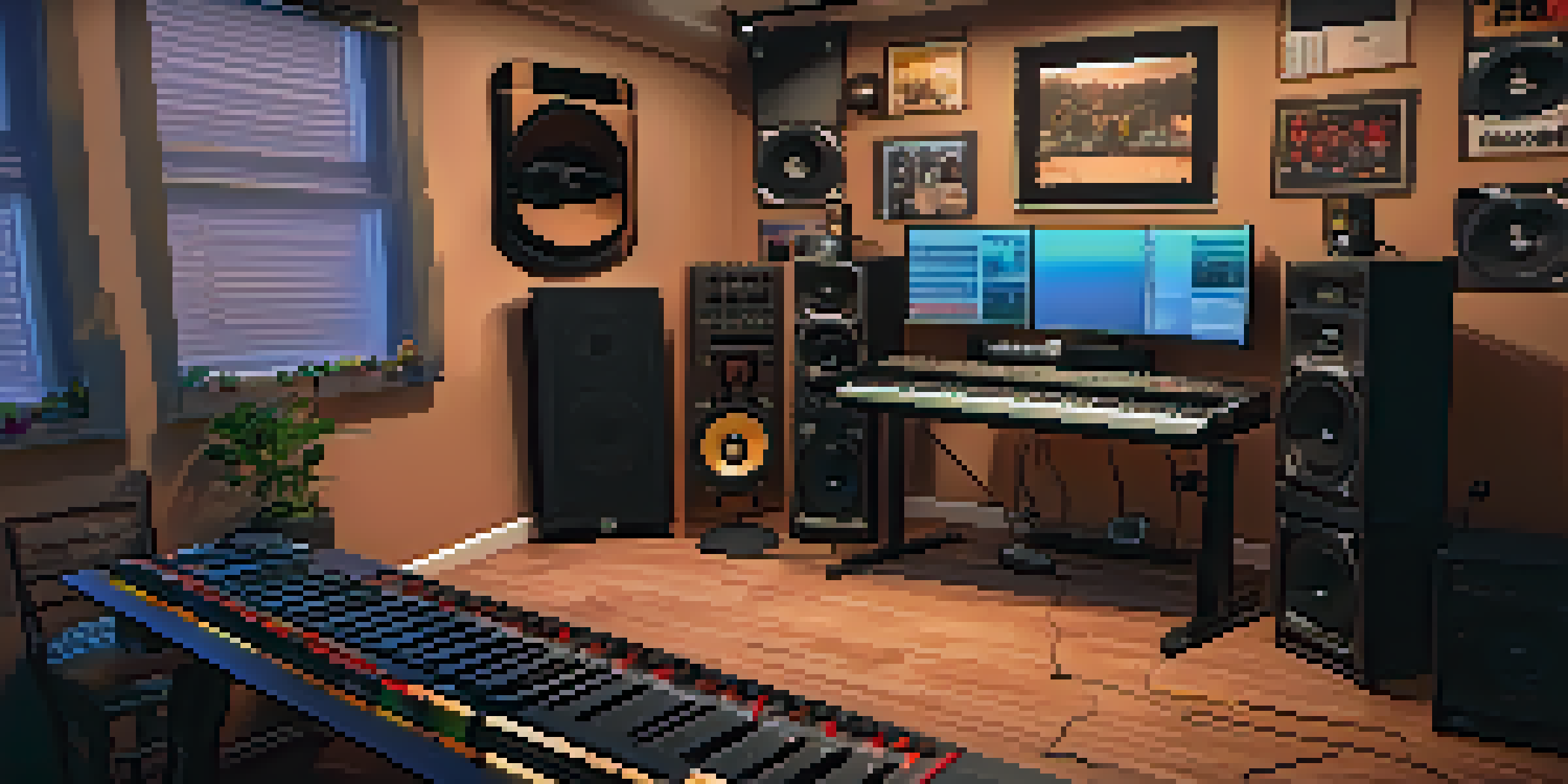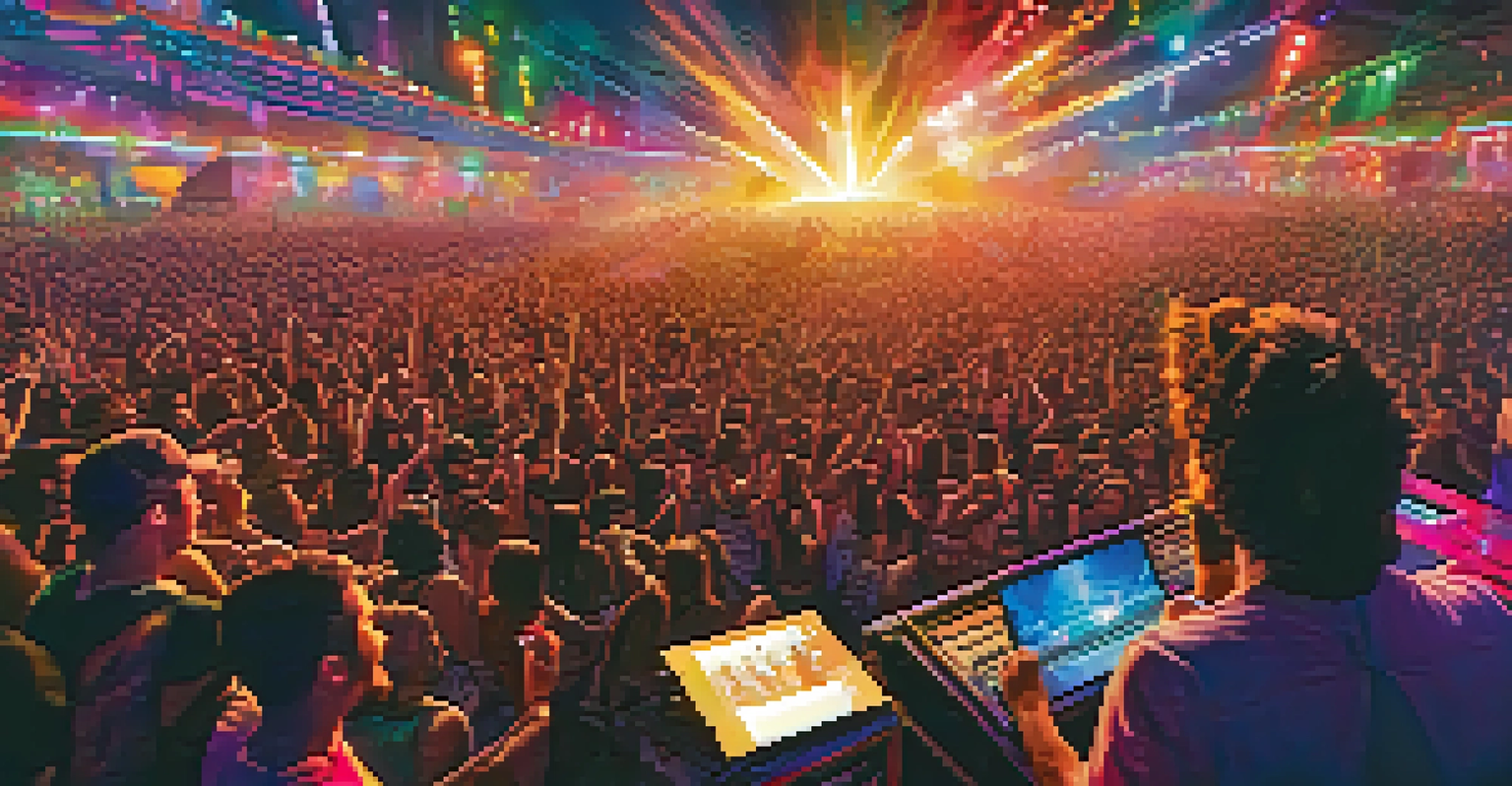The Digital Audio Revolution and Its Musical Impact

Understanding the Digital Audio Revolution
The digital audio revolution refers to the shift from analog to digital methods of recording, producing, and sharing music. This transformation has not only changed how music sounds but also how it's made and experienced. Imagine moving from vinyl records, which can be fragile and limited in quality, to digital files that can be streamed or downloaded instantly.
The beautiful thing about music is that it transcends language.
With digital audio, artists gained unprecedented access to high-quality production tools, even from their homes. This democratization of technology has opened doors for bedroom producers to create chart-topping hits without needing a big studio budget. It’s similar to how the advent of the printing press changed literature, allowing more voices to be heard.
Ultimately, this shift has led to a more diverse music landscape where independent artists can thrive. The possibilities are endless, and the music industry is evolving at a pace that was unimaginable just a few decades ago.
The Impact of Music Streaming Services
Music streaming services like Spotify and Apple Music have revolutionized how we consume music. No longer are listeners confined to purchasing entire albums; they can now access millions of songs with a click of a button. This on-demand model has fundamentally changed listener habits, making it easier than ever to discover new artists.

However, this convenience has come with its challenges. Artists often struggle to earn a fair wage from streaming platforms, leading to debates about the sustainability of this model. It's akin to a double-edged sword—while it promotes access and discovery, it also raises questions about the value of musical work.
Digital Audio Revolutionizes Music
The shift from analog to digital has democratized music production, empowering independent artists and diversifying the industry.
Despite these challenges, streaming services have played a crucial role in breaking down geographical barriers. A small band from a remote town can now reach listeners worldwide, showcasing the power of technology in music distribution.
How Digital Audio Changed Music Production
The advent of digital audio workstations (DAWs) has transformed music production, allowing musicians to record, edit, and produce music with ease. Programs like Pro Tools and Ableton Live have revolutionized the studio environment, enabling artists to experiment and create without the constraints of traditional recording methods. It’s like having a full-fledged recording studio right on your laptop.
Music is the shorthand of emotion.
This shift has also fostered creativity, as musicians can layer sounds, tweak pitches, and manipulate their tracks in ways that were previously impossible. Imagine being able to adjust the tempo of a song on the fly or adding effects with just a few clicks—this flexibility has opened up new avenues for artistic expression.
As a result, we see a greater variety of genres and sounds emerging, with artists blending styles in innovative ways. The barriers to entry have lowered, allowing for a richer tapestry of musical creativity in the digital age.
The Role of Social Media in Music Promotion
Social media platforms like Instagram, TikTok, and Twitter have become essential for artists to promote their music and connect with fans. These platforms enable musicians to share snippets of their work, behind-the-scenes content, and engage directly with their audience. Think of it as a virtual stage where every artist can showcase their talent.
Moreover, viral trends can catapult unknown artists to fame overnight, demonstrating the power of social media in shaping the music industry. A simple dance challenge on TikTok can lead to millions of streams for a song, illustrating how interconnected our digital lives have become.
Streaming Services Change Listening Habits
Music streaming platforms have transformed how we consume music, providing easy access but raising concerns about fair compensation for artists.
However, this reliance on social media also creates pressure for artists to constantly produce content and engage with fans. Balancing the demands of social media while maintaining artistic integrity can be challenging, yet many find innovative ways to thrive in this environment.
The Evolution of Music Genres in the Digital Age
Digital audio has played a significant role in the evolution and fusion of music genres. With access to a vast array of sounds and production techniques, artists are increasingly blending different styles to create unique musical experiences. For instance, the rise of genre-blending artists like Lil Nas X showcases how digital tools can break traditional genre boundaries.
This blending of genres has led to the emergence of new sub-genres, making the music landscape more diverse than ever. Think of it as a melting pot where hip-hop, country, electronic, and pop collide, resulting in innovative sounds that appeal to a broad audience.
Additionally, streaming algorithms often promote genre diversity, encouraging listeners to explore music they might not have discovered otherwise. This exposure fosters a richer understanding of music culture and promotes inclusivity within the industry.
Challenges Faced by Artists in the Digital Era
While digital audio has opened doors for many artists, it also presents significant challenges. One major issue is the oversaturation of the market, making it hard for new artists to stand out. With millions of songs available, how does one get noticed amidst the noise? It’s like trying to find a needle in a haystack.
Moreover, the dependency on streaming platforms for income raises concerns about fair compensation. Many artists find it difficult to make a living, leading to ongoing discussions about the need for better pay structures within the industry. The reality is that while access has increased, so have the hurdles.
Social Media Shapes Artist Promotion
Social media has become crucial for artists to promote their music and connect with fans, though it also creates pressure to constantly engage.
Despite these challenges, many artists find ways to adapt and thrive. Crowdfunding, merchandise sales, and live performances are just a few avenues that musicians are exploring to sustain their careers in this new landscape.
The Future of Digital Audio and Music Industry
As technology continues to advance, the future of digital audio and the music industry looks promising yet uncertain. Innovations like artificial intelligence in music production and personalized listening experiences are on the rise. Imagine a world where AI can compose music tailored to your mood—this isn’t science fiction; it’s becoming a reality.
Additionally, virtual reality (VR) and augmented reality (AR) are starting to play a role in how we experience music. From immersive concerts in virtual spaces to AR apps that enhance live performances, the way we engage with music is evolving rapidly. It’s like stepping into a new dimension of musical experience.

Ultimately, the ongoing evolution of digital audio will continue to shape the music industry in ways we can’t yet fully predict. As artists and technology intertwine, we can expect a future filled with creativity, innovation, and new possibilities.